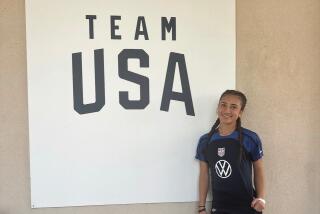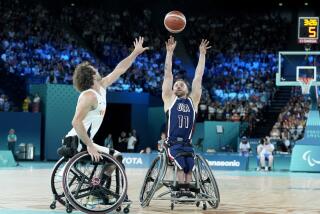For young athletes in training
Memo to parents with children entering the world of competitive sports: It’s not the way you remember it.
A plethora of organized sports teams and the resulting competition has bred an industry of supplemental training: private coaches, sports camps and now private training facilities such as Velocity Sports Performance, which opened its first California branch in Irvine three weeks ago.
This national franchise of sports training facilities aims to help athletes improve their speed, agility, flexibility and strength. Co-founded in 1999 by football and track coach Loren Seagrave, Velocity also trains adult athletes, but its focus is on children. The approximate cost for three months of twice-weekly 90-minute sessions: $1,440.
Velocity’s purpose is not, says Seagrave, to create a generation of super-competitors, but “to get them off the bench, get into the game, experience more playing time, have more fun, stay in sports longer and enjoy the benefits from all the great things sports teaches.”
The extra training offered by Velocity and Acceleration Minnesota, another sports training facility with a chain of nationwide spinoffs, is based on the premise that the workouts kids get from their PE teachers, Little League coaches, soccer coaches and the like may not be that good, and may not be enough. Because coaching positions often are filled by parent volunteers -- with varied backgrounds and expertise -- children may be getting incorrect and conflicting information.
And the youth sports themselves have evolved. In some neighborhoods, spontaneous pickup games on the schoolyard, where any kid could play, are practically extinct. Now many sports, such as baseball and soccer, are organized, whether it’s a school team, youth league or club. Competition can be tough, and having extra training can mean the difference between getting a spot on a team or not.
“I don’t think it’s a bad idea as long as the kid wants to do it, it’s their idea and they’re not getting hurt,” says Dr. William O. Roberts, an associate professor at the University of Minnesota who specializes in sports medicine. “To be honest, some of the people in these training centers are probably way more qualified than the volunteer coaches in youth programs -- not to denigrate them, but I’ve watched a lot of people make a lot of mistakes.”
Jim Brownfield, former football and girls’ track coach at John Muir High School in Pasadena and current West Coast director of the National High School Athletic Coaches Assn., says he had no problem recommending a sports camp or trainer when a child or parent requested it, as long as the child wasn’t overdoing it. “It’s important to keep them active without burning them out,” he says. “We always made sure they had leisure time, and time to be kids.”
But leaving time just to be a kid may not be on the minds of some parents who see in their talented progeny the promise of college scholarships and lucrative pro contracts, and so start pushing them from an early age.
“Parents are more involved than ever,” says Jerry Miles, executive director of the National High School Baseball Coaches Assn. “They want to see their kids do better, maybe get a huge contract; that’s becoming more prevalent. Maybe they see their son going on where they didn’t.”
Troy Medley, the Irvine Velocity’s chief executive, says parents are asked to read and sign a two-page “Behavior and Regulation Guidelines” form before allowing their kids to participate. Among the rules: “Using abusive, harassing, profane or obscene language or racial epithets directed at anyone is prohibited.”
“We try to spend about 60% of the interview talking to the child, finding out what they’re looking for,” he says. “We have told parents that this probably isn’t the program for them if they want someone to teach their child how to be a better pitcher, or if they want to overwork their child.”
The Irvine Velocity is a 19,000-square-foot indoor facility that includes a 35-yard Astroturf field, a four-lane, 53-yard padded track, weight machines, squat racks, dumbbells and one treadmill. Training, led by experienced coaches (some with college-level experience), is not sports-specific but includes speed drills, strength training and agility moves that are inherent in almost every sport. Programs for children ages 11 to 18 are structured workouts, and younger kids participate in less intense, game-oriented workouts. The company expects to open 15 to 20 more franchises by year’s end.
On a recent weekday, three mothers sat in the Irvine facility’s waiting room while their children went through a 90-minute workout that included a warmup, speed drills, Olympic lifts and squats with barbells, and abdominal work (parents and outside coaches are not allowed on the training floor). Kristie Manchin’s 13-year-old son Kyle, a baseball player, and 11-year-old daughter Cindy, who plays softball, asked to come when they saw an ad in the newspaper. “My kids lack speed, and I thought coming here would help with that part of their game,” she says. Next year Kyle will be trying out for the high school team, “so there’s a lot more reasons to improve at this point.”
The extra training, Manchin adds, “wouldn’t be something that I would have pushed them to do. The ultimate goal is confidence and letting them feel good about themselves and be healthier and stronger and not get hurt.”
Kyle is happy with the results so far: “It’s a lot of fun,” he says. “They work a lot more on technique and power than we do at school.”
Gigi Cole of Mission Viejo says she’s seen improvements in her twin 15-year-old daughters, Kalynn and Andrianna, who are on the tennis team at Mission Viejo High School. “It’s helped Kalynn tremendously with her shots,” she says, and Andrianna with her speed and agility. “Thirty years ago we didn’t have this -- they didn’t even let girls do weights. They’re learning how to maximize what they have.”
“We’re already good athletes,” says Andrianna, “but this makes us even better.... We might have a little more of an edge at making a higher spot on the team.”
The ability to afford extra coaching may be making the playing field a little less level. Training at places such as Velocity or sports camps are, so far, a privilege not everyone can afford, but Seagrave says the sessions are no guarantee of success. Many top athletes have achieved greatness despite economic hardships, and no doubt will continue to do so.
Seagrave says his company’s goal is not to make professional athletes or help people get college scholarships. “It’s to open up opportunities for them to enjoy sports more.”
More to Read
Go beyond the scoreboard
Get the latest on L.A.'s teams in the daily Sports Report newsletter.
You may occasionally receive promotional content from the Los Angeles Times.









